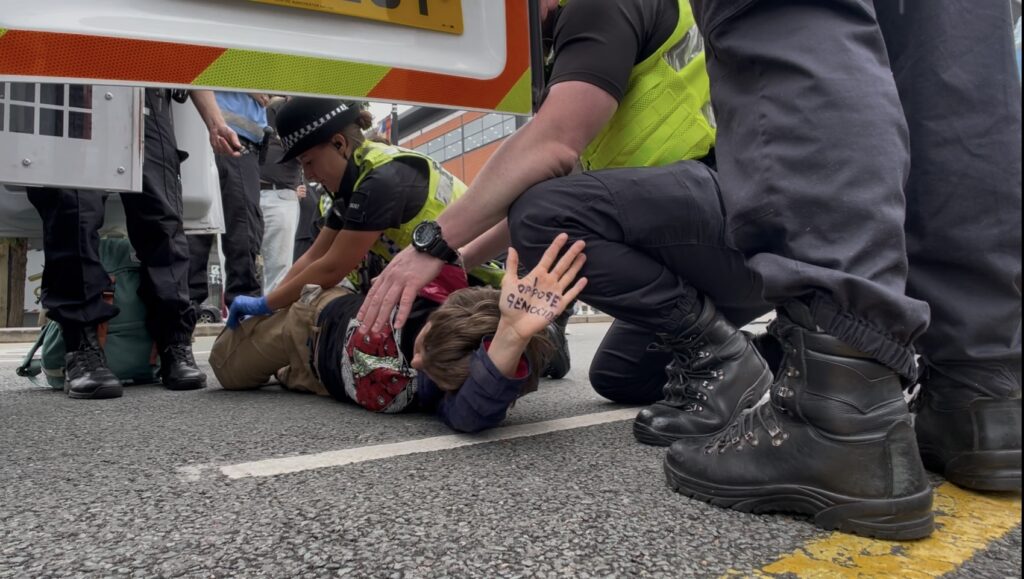Guest video and report by Rebecca Harrison; Running time 9 mins 37 secs
On July 19, 16 peaceful protestors arrive at the Gandhi statue in Manchester. For the second Saturday running, people have decided to participate in the ‘Lift the Ban’ campaign organised by Defend Our Juries (DOJ) to oppose genocide and protest the government’s proscription of Palestine Action.
As reported for Reel News last week, the first such demonstration on July 12 was characterised by police violence. Greater Manchester Police (GMP) appeared to assault not only the sitters who gathered silently around the Emmeline Pankhurst statue, but also people who had attended a nearby Palestine-solidarity march. Far-right vloggers abused and assaulted people in the crowd with impunity.
The second action passes more quietly, if no less oppressively, than the first. At 11.50 am, ten minutes before the sitters are due to arrive, there are police patrolling the area in small groups (DOJ inform police of demonstrations in advance). Two GMP officers stand across the street from the statue, talking to two women. There is another group of people—not police—hanging around close by.
The two women, and the nearby group, are part of the far-right vlogging community who attended the DOJ demonstration on July 12 to heckle, goad, and in some cases assault people. The women do not seem to be interviewing the police; they are not using microphones or filming them.
At midday, 16 DOJ demonstrators feed into the square and take up their sitting positions between the Gandhi statue and the Cathedral. Wearing rain coats to fend off the persistent drizzle, some are cross-legged on the floor, while others perch on camping chairs. They take out signs which read ‘I oppose genocide. I support Palestine Action’. The Cathedral bells briefly drown out the Oasis tracks blaring from a nearby café. Heads bowed, the demonstrators mostly refuse to acknowledge the first warning given by police, which relates to Section 13 of the Terrorism Act 2000.

Within a few minutes, police begin the arrests. People are grabbed under their arms by arresting officers and lift their legs to prevent their feet, shins and knees scraping along the tarmac. The police ask one older activist, who they have just dragged across the square until she collapses down onto the pavement, what she needs to reach the van. Later, an officer checks that someone lying on the ground mid-arrest can breathe, before offering them a choice between entering the van of their accord or being subjected to police ‘force’.
The far-right vloggers make their presence felt throughout. They are social-media content creators who share videos that include by turns racist, anti-immigrant, transphobic, and nationalist rhetoric, and conspiracy theories (one of them alleges at the July 19 action that members of Palestine Action are responsible for murder in the USA). A brief survey of their channels reveals that they often appear in one another’s footage, with videos of their group picking fights with people of colour, harassing Black men on the basis that they may be refugees, and chanting ‘kick them out’ at a far-right gathering in the city centre.
There are worrying signs that Greater Manchester Police may be facilitating the group’s presence at DOJ demonstrations. Vloggers arrive early ahead of the actions, and are in close proximity to officers at the second action. At the time of writing, I understand that Defend Our Juries share demo details (start times and locations) only with press and police. In a video posted to his YouTube channel on July 13, one vlogger seems to suggest that ‘They [Defend Our Juries] leaked an email to GMP saying “We’re going from here, we want to be arrested, blah blah blah”.’ He does not explicitly allege that police shared details about the action with him or his group, and he may be referring to another organisation.
Nevertheless, he implies that the so-called ‘leak’ has informed his awareness of the protests. Between July 1 and 20, GMP did not release any details about the DOJ actions publicly via the force’s official X or Instagram accounts.
Many GMP officers seem to accept, or even welcome, vlogger attention. During their first warning to demonstrators beside the Gandhi statue, for example, one officer tells the person videoing over her shoulder not to film so close to her face. ‘It’s for the content’, the vlogger responds, ‘we want to see you.’ The officer smiles and laughs. ‘Oh, no worries,’ she says.
A short time later, a man providing support to the sitters positions himself near to a woman who police are about to arrest. On this occasion, a police officer stands between them, instructing the man to get back, denying him and the about-to-be-arrested demonstrator the security that external observation of police activity can afford. Yet, as officers hold the demonstrator’s arms and lead her away, vloggers continue to film her at close quarters.
Just one GMP officer makes any attempt in my hearing to prevent vloggers from filming people without consent during the arrests.
The DOJ activists are clear about their justifications for taking action. One holds their hand aloft throughout their arrest, ‘I oppose genocide’ inked on their palm. To applause and cheers from supporters, another calls the government supply of arms to facilitate the murder of Palestinian children ‘disgusting’.
But whether GMP conduct is justifiable is far from clear, with officers’ behaviour at DOJ demonstrations raising serious questions about their use of violence during arrests (there is an ongoing investigation into their use of force by the Independent Office for Police Conduct), their treatment of people attending peaceful protests, and their relationships with the far-right.
In the wake of anti-genocide and anti-proscription actions across the four nations (and with a successful legal challenge against Palestine Action’s proscription in the High Court resulting a full judicial review), there’s uncertainty, too, about how much longer the UK government will remain complicit in violence against Palestinians, and continue to prevent people from standing—or sitting—in solidarity with them.



